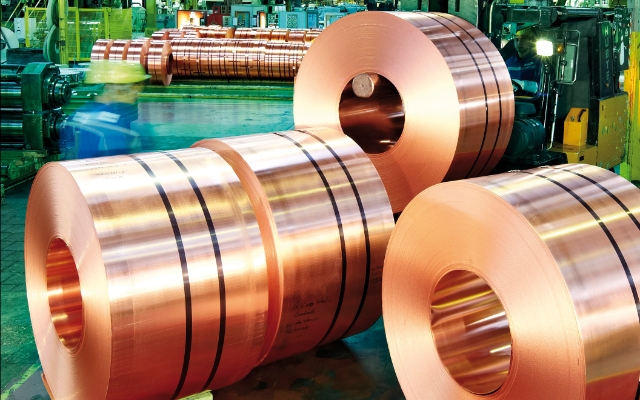Just How Copper Products Add To Sustainable Practices in Numerous Fields
In eco-friendly power systems, for example, copper enhances the functionality of solar and wind modern technologies, while its application in building minimizes waste through longevity. As industries seek to adopt more lasting methods, the role of copper could confirm essential in accomplishing ecological goals.
Copper in Renewable Resource
Copper plays a vital duty in the improvement of renewable resource modern technologies, offering as a vital conductor in different applications. Its phenomenal electrical conductivity and resistance to deterioration make it a perfect product for electrical circuitry, which is essential in solar panels, wind turbines, and power storage space systems. In solar photovoltaic systems, copper is made use of in the interconnections and wiring, enabling reliable power conversion from sunlight to power.
In wind power, copper is integral to the generators and transformers that transform kinetic energy into electric energy, making sure optimum performance and integrity. Additionally, the need for electric cars (EVs) is boosting, with copper being a key element in batteries, electric motors, and billing facilities. The transition to EVs dramatically boosts the need for copper, as these automobiles normally utilize 4 times a lot more copper than traditional internal combustion engine lorries.
As the globe looks for to reduce climate adjustment and transition to lasting power resources, copper's role comes to be increasingly vital. The material not just improves the effectiveness and toughness of renewable resource systems but also supports the broader objective of decreasing greenhouse gas discharges and advertising a lasting future.
Eco-Friendly Building Products
Over the last few years, there has been a remarkable change towards the adoption of environmentally friendly building materials in feedback to expanding ecological problems. This modification is motivated by the requirement for lasting options that lessen environmental footprints while maintaining architectural integrity and aesthetic allure.
Copper, recognized for its longevity and recyclability, has actually become an essential gamer in this field. It can be utilized in roof covering, pipes, and electrical systems, adding to power effectiveness and reducing waste. Copper's long life means fewer substitutes in time, further improving its sustainability profile.
In addition, materials such as bamboo, redeemed timber, and recycled steel are obtaining popularity. These alternatives not only supply lowered environmental impact but likewise promote source conservation. As constructing codes progressively stress sustainability, home builders and architects are integrating these products into their jobs, fostering technology in design.
The enhancing fostering of eco-friendly building and construction materials mirrors a wider dedication to sustainability in the built atmosphere. By focusing on these materials, the building industry can substantially lower its carbon impact, align with regulatory standards, and sustain a much healthier environment for future generations. This trend notes a pivotal action in the direction of an extra sustainable future in building.
Copper's Role in Medical care
Recent studies have highlighted the significant function of copper in healthcare settings, especially due to its antimicrobial buildings. Copper surface areas have actually been revealed to lower the visibility of microorganisms, including microorganisms and viruses, by as much as 99.9% within a short period. This exceptional efficacy makes copper an invaluable product for high-touch surface areas in health centers, such as doorknobs, bed rails, and IV posts, consequently adding to improved infection control procedures.
In addition to its direct antimicrobial impacts, copper likewise plays a duty in the broader context of healthcare facility sustainability (Copper Products). By including copper into medical tools and check over here furnishings, healthcare centers can lower the occurrence of healthcare-associated infections (HAIs), which not just boosts individual outcomes but also decreases the costs related to extended health center stays and added treatments
Moreover, copper's toughness and recyclability straighten with lasting methods, permitting for responsible resource management. As healthcare systems significantly focus on both person safety and ecological stewardship, the combination of copper products is becoming much more widespread. This dual advantage highlights copper's essential contribution to a much healthier, much safer, and a lot more sustainable healthcare atmosphere.
Sustainability in Transport

Furthermore, copper's durability and deterioration resistance add to the durability of transport infrastructure (Copper Products). In rail systems, for example, copper parts enhance the dependability and efficiency of signaling and power systems, vital for minimizing hold-ups and power intake. In addition, copper's duty in sustainable power systems, such as solar and wind, sustains sustainable transport remedies by supplying clean energy for electric transportation options
Investments in copper modern technology not just foster sustainability however also stimulate economic growth and task production in environment-friendly fields. As industries make every effort to meet rigid ecological laws, the application of copper products in transportation becomes a critical technique in achieving sustainability goals and advertising a cleaner, more efficient future.
Copper and Circular Economy
As the globe significantly welcomes sustainability, the function of copper this in the round economic situation ends up being ever more substantial. Copper's innate residential or commercial properties-- such as its sturdiness, conductivity, and recyclability-- setting it as a key product in a resource-efficient economic climate. The circular economy intends to minimize waste and take full advantage of source usage via recycling and reusing products, and copper excels in this respect.
The metal can be recycled indefinitely without loss of high quality, making it a perfect candidate for sustainable techniques throughout various markets, including building and construction, electronic devices, and sustainable power. By recycling and recuperating copper from end-of-life products, markets can significantly lower the requirement for virgin materials, therefore lowering environmental effects connected with mining and processing.
Moreover, the assimilation of copper into round economy structures not only saves resources yet additionally promotes innovation. Services that focus on copper reusing add to a more lasting supply chain, boosting their competition while lining up with regulative needs and consumer choices for eco responsible products.
Verdict
Finally, copper items substantially contribute to lasting techniques across multiple markets. Their essential function in boosting renewable energy innovations, promoting environmentally friendly building products, supporting infection control in health care, facilitating lasting transportation, and embodying the principles of a circular economic climate emphasizes the flexibility and significance of copper. By incorporating copper into numerous applications, industries can Visit Website attain better performance, decrease ecological effect, and line up with worldwide sustainability goals, eventually fostering an extra sustainable future.

Copper's outstanding conductivity makes it a recommended product in electric vehicle (EV) systems, boosting energy performance and efficiency. Furthermore, copper's function in eco-friendly power systems, such as solar and wind, supports sustainable transport services by providing clean energy for electrical transit choices.
Their necessary role in improving eco-friendly power modern technologies, advertising environmentally friendly building products, sustaining infection control in healthcare, facilitating lasting transport, and embodying the principles of a circular economy highlights the convenience and value of copper.